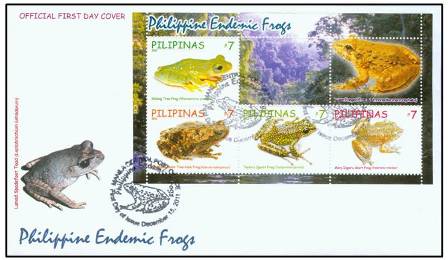2011, December 15. Philippine Endemic Frogs
Litho Offset. APO Productions Unit. Perf. 13 x 13 1/4
Se-tenant Blocks of 4, Miniature Sheets of 16 (4 x 4); Souvenir Sheets of 4
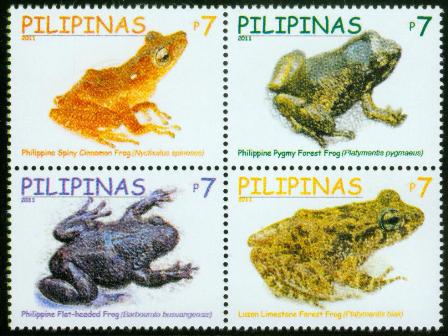
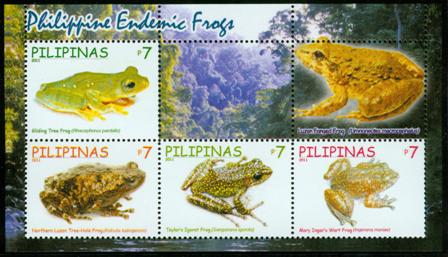
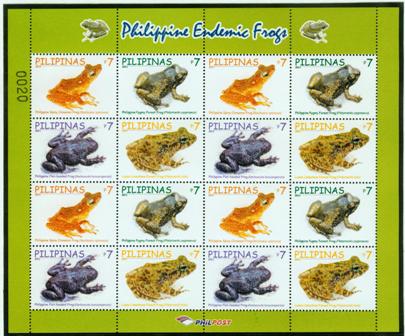
Se-tenant Blocks of Four (26,250)
7p Philippine Spiny Cinnamon
7p Philippine Pygmy Forest Frog
7p Philippine Flat-headed Frog
7p Luzon Limestone Forest Frog
Miniature Sheets of 16 (6,527)
Souvenir Sheets of Four (5,000)
7p Gliding Tree Frog
7p Northern Luzon Tree-hole Frog
7p Taylor's Igorot Frog
7p Mary Inger's Wart Frog
Text and photos: Provided by Dr. Arvin C. Diesmos, Ph.D., Scientist II, In-charge of Herpetology Section, Zoology Division, National Museum of the Philippines.
Designer/ Lay out Artist: Victorino Serevo
First Day Covers: Manila
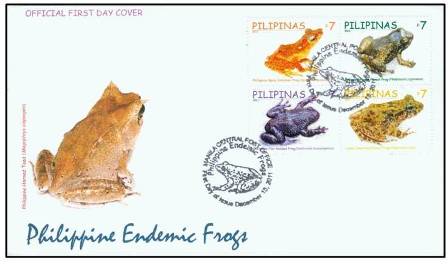
ENDEMIC FROGS OF THE PHILIPPINES
On Blocks of Four:
Philippine Spiny Cinnamon Frog (Nyctixalus Spinosus. Endemic to the Philippines and is native to Mindanao, Leyte, Bohol and Basilan Islands, with an altitudinal range of 500-1,100 m above sea level. It probably occurs more widely than current records suggest, especially in areas between known sites. It inhabits the forest floor litter of mountain and lowland rainforests, as well as submontane dipterocarp forest. It lays its eggs in tree holes, around 30-40 eggs that are probably attached to the walls of tree holes. Tadpoles of this species have been found in tree holes that develop when tree limbs have been broken off and adjacent tissue has decayed, forming tanks from anastomosed trunk (http://amphibiaweb.org/cgi/amphib_query?where-genus=Nyctixalus&where-species=spinosus)
Philippine Pygmy Forest Frog (Platymantis pygmaea). Endemic to the Philippines. Its natural habitats are subtropical or tropical dry forests, subtropical or tropical moist lowland forests, and subtropical or tropical moist montanes. It is threatened by habitat loss. Found mostly in Northern Sierra Madre Mountains in the provinces of Isabella, and Kalinga-Apayao. Smallest among Philippine Platymantis, with smooth skin and dark spot surrounding anus and usually another irregular dark spot in proximal anteroventral part of upper arm and adjacent region.
Philippine Flat-headed Frog (Barbourula Busuangensis). A large, heavy-bodied, highly aquatic frog found in the fast-moving waters of mountain streams on the Philippine islands of Busuanga and Palawan. Adaptations to this life-style include a dorsoventrally flattened body shape, dorsally placed nostrils and eyes, robust and muscular hind limbs and forelimbs, and webbed digits on the forelimbs as well as the hind limbs. The body is covered with numerous very fine warts that increase in size laterally from the midline. This species is dark in color, from dark green to black, with faint lighter green blotches and crossbars on the hind limbs. Within Palawan and Busuanga, they are restricted to clean, cool, mountain streams in undisturbed forest. In these streams, this species can be found floating at the water surface with only its eyes and nostrils visible, or amongst rocks in fast flowing water. However, this species is very wary and quick to hide underneath submerged rocks when disturbed, which may explain why this frog remains so elusive. (http://amphibiaweb.org/cgi/amphib_query?where-genus=Barbourula&where-species=busuangensis)
Luzon Limestone Forest Frog (Platymantis Biak). The historic Biak na Bato National Park in Bulacan is the site of a significant discovery. It is where a team of researchers—including College of Science professor Mae Lowe Diesmos and husband Arvin of the Philippine National Museum—discovered a new frog species belonging to the Platymantis genus. With the group were Rafe Brown, Cameron Siler, and Charles Linkem of the Kansan University in the United States. The new find was christened Platymantis Biak, in recognition of the natural reserve. In 2009, Diesmos and her team started a study on amphibians and reptiles at the park. After field surveys of reptile and amphibians in the area, they concluded that the find was indeed a new frog species. Platymantis biak are usually spotted in their microhabitats—limestone crevices or gaps found in caves in Biak na Bato National Park. Frogs thrive in moist places like these, where temperature is naturally low. Like the usual Platymantis, the Platymantis biak also has moderately expanded fingers and toe discs. But it differs from other genuses because it confines itself to terrestrial habitats. The Platymantis genus is sensitive to changes in temperature. (http://www.varsitarian.net/sci_tech/20101029/limestone_wonder)
On Souvenir Sheets:
Gliding Tree Frog (Rhacophorus Pardalis). Small to medium in size, with males reaching 39-55 mm and females 55-71 mm. Snout is rounded. Fingers III, IV, V are fully webbed and bear expanded discs. The outer edge of the hand and forearm have a wide flap of skin. Toes are fully webbed. The heel has a rounded flap of skin. Dorsum is tan to reddish brown, often with an X-shaped darker marking on the back. Several white spots are often present, with some individuals having yellow or blue spots on the dorsal surfaces. Flanks are yellowish with black spots. Venter is yellowish with orange reticulation. Webbing is orange-red. This frog uses its heavily webbed hands and feet to glide. It presumably forages in canopy. It gathers in breeding aggregations in swampy forest, at marshes, ponds and quiet pools, and is common along logging roads where streams are blocked and form pools. (http://amphibiaweb.org/cgi/amphib_query?where-genus=Rhacophorus&where-species=pardalis)
Northern Luzon Tree-hole Frog (Kaloula Kalingensis). This species is found in the mountains of the Central Cordilleras and possibly in the Sierra Madres, on northern Luzon Island, and Polillo and Palaui in the Philippines. It inhabits lower montane and lowland forests, but occasionally is also found in forest edge habitats. It lives in water-filled tree holes and hollows. Tadpoles have been collected in the same microhabitats. The most important threat to this species is the deforestation of lower montane and lowland forests in the Cordilleras. The montane forests are either being converted to vegetable farms or are being developed into real estate. Only a few protected areas, such as Pulag National Park, are currently found in this region of the Philippines. There is a need for increased protection of the remaining tracts of intact lowland and montane rainforest in the Cordilleras.
(http://amphibiaweb.org/cgi-bin/amphib_query?where-scientific_name=Kaloula+kalingensis)
Taylor’s Igorot Frog (Sanguirana Igorota). Sanguirana igorota is known from Luzon Island in the Philippines. They are found near water, along the banks of streams. They can be distinguished from other members of the Sanguirana everetti complex by a combination of the following characters: (1) fine dorsal asperities present (2) infracloacal tubercles present (3) tibial bars present (4) dark dorsal spots present (5) dark canthal stripe present (6) snout squarish (7) ventral surface tuberculate around the groin (8) dorsolateral ridges present. Dorsal surface is bright green with dark spots. (http://philbreo.lifedesks.org/pages/6787)
Mary Inger’s Wart Frog (Ingerana Manae). A species of frogs in the Ranidae family. It is endemic to the Philippines. Its natural habitat is subtropical or tropical moist montanes. It is threatened by habitat loss. More specifically, Ingerana mariae is considered to be Critically Endangered and facing an extremely high risk of extinction in the wild due to a population size estimated to number fewer than 250 mature individuals. It’s population trend is unknown at last assessment. Type locality: "south slope of Mount Balabag, Mantalingajan Range, Palawan", Philippines.
On Souvenir Sheet as a label:
Luzon Fanged Frog (Limnonectes Macrocephalus). This species has been recorded from many localities on Luzon, Catanduanes, Marinduque and Polillo Islands, in the northern Philippines. Its natural habitats are subtropical or tropical moist lowland forests, subtropical or tropical moist montane forests, rivers, intermittent rivers, freshwater marshes, intermittent freshwater marches, coastal freshwater lagoons, arable land, pastureland, and plantations. The major threats to this species include habitat loss, due to expanding agriculture, logging and human settlements, and the pollution of streams and rivers. Harvesting by local people is also a threat.
-
Amphibians
-
Animals
